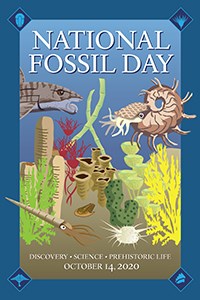News Release
Date: October 14, 2020
Contact: NewsMedia@nps.gov

NPS Photo
Fossils, fossils, fossils! Whether you’re a fan of sharks, prehistoric footprints, or other ancient animals and plants, the National Park Service has fossils for you, including a couple of amazing new discoveries. And there’s no better day to celebrate and start to learn about fossils than on National Fossil Day.
October 14 is the day the National Park Service and more than 385 partners throughout the U.S. will host the 11th annual event, with many activities this year taking place virtually. This national celebration promotes fossils and the work of scientific and educational partners providing information about what life was like waaaaay back in the day. The National Park Service has a fun list of 20 ways to celebrate National Fossil Day in 2020.
“Fossils in national parks preserve remnants of life that span more than a billion years of Earth's history,” said National Park Service Senior Paleontologist Vincent Santucci. “It is exciting to find fossils, but just as important to protect them for scientific study and public education. Some of these fossils connect us to animals and plants that lived millions of years ago and serve as a reminder of the importance of public lands as places of awe, discovery and preservation.”
More than 275 national parks contain fossils. Two that are highlighting recent discoveries are White Sands National Park which uncovered the longest Ice Age human trackway and Mammoth Cave National Park which discovered six new shark species fossilized deep in the cave.
Several websites feature fun and educational fossil related activities. The new Prehistoric Life in the National Parks coloring book features 40 original line drawing illustrations that depict prehistoric life known from national parks around the country. Fossils Through Geologic Time in the national parks demonstrates the great diversity of prehistoric animals and plants which have been documented by paleontologists in national parks. Kids can also become Junior Paleontologists and download an activity booklet that will help them explore the work of paleontologist and the methods and tools they use to understand ancient life. And enjoy the talent of the young winners of the 2020 National Fossil Day art contest.
Some of the recent fossil discoveries in national parks include:
Ice Age Footprints Discovered at White Sands National Park – Scientists at White Sands National Park have discovered a path almost a mile long of fossilized human footprints – the longest Pleistocene (ice age) human trackways found anywhere in the world. The asymmetries in the footprints of the trackway tell a story of a human likely walking with a toddler in his or her arms, shifting the young one from one side to the other and at times letting the toddler walk alongside. The trackways were also crosscut by the tracks of a giant ground sloth and a Columbian mammoth.
Mammoth Cave National Park Fossil Inventory Project – A team of paleontologists, cave specialists, and park rangers at Mammoth Cave National Park have discovered a trove of fossil treasures that has yielded one of the most diverse Mississippian shark faunas in North America. At least 40 different species of sharks and their relatives have been identified, including six new species. Rare preservation of three-dimensional skeletal cartilage documented in Mammoth Cave allows us to understand the anatomy and relationships of these ancient sharks.
George Washington Birthplace National Monument Fossil Dolphin Rescue – In February 2020, park rangers at George Washington Birthplace National Monument discovered exposures of fossil bones along the shoreline during routine monitoring along the monument’s cliffs. Paleontologists identified the exposed bones as belonging to a marine mammal. Emergency salvage collection in March showed that the bones were the partial skull of an ancient long-nosed dolphin. A second dolphin skull was discovered the same day. Both specimens were successfully recovered and are being prepared by paleontologists at the Calvert Marine Museum in Solomons, Maryland.
About the National Park Service. More than 20,000 National Park Service employees care for America's 421 national parks and work with communities across the nation to help preserve local history and create close-to-home recreational opportunities. Learn more at www.nps.gov, and on Facebook, Instagram, Twitter, and YouTube.
Last updated: October 14, 2020
